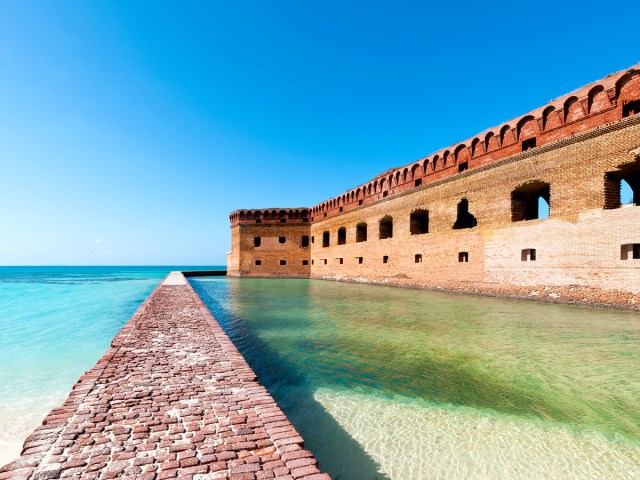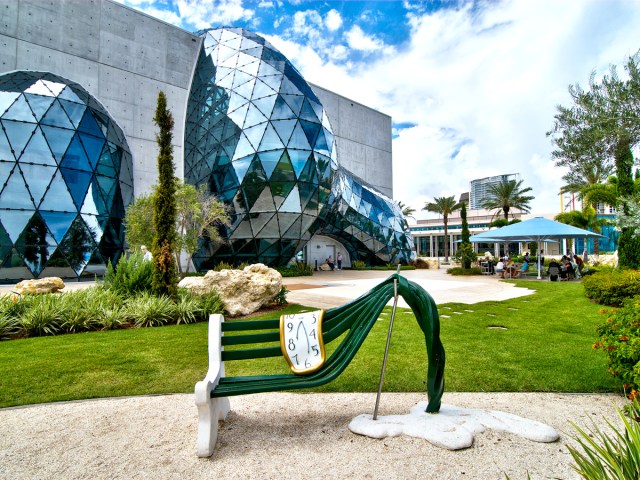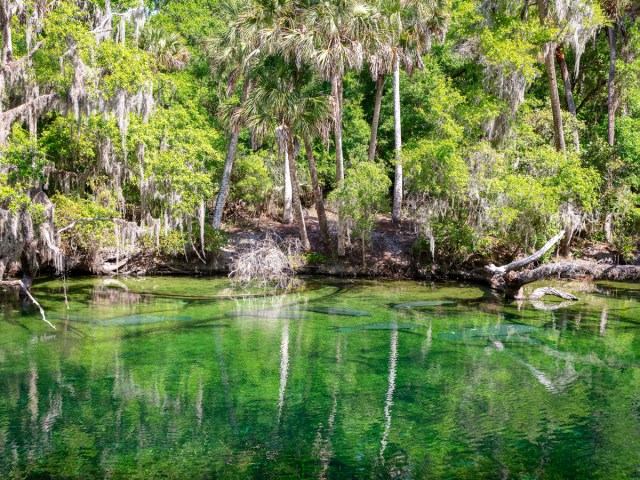Florida is one of America’s most-visited states, and with a nickname like the “Sunshine State,” it’s easy to guess why. Surely, the state’s 825 miles of beaches are the star of the show, but Florida’s abundance of theme parks, nightlife, and opportunities for outdoor recreation all help drive millions of annual tourist visits, too. If you’re looking for underrated places to visit in Florida where you can avoid crowds, consider these six destinations.
Dry Tortugas National Park

Whatever draws you to Dry Tortugas National Park, be prepared to spend some time in the water. Despite the park’s name, terra firma accounts for less than 1% of the 100-square-mile site, located 70 miles off the coast of Key West. One thing you will find? Turtles. Explorer Ponce de León originally called the area Las Tortugas (Spanish for “The Turtles”) because of how many of the sea creatures he saw swimming in the water. It’s no different today, with five turtle species mingling among the park’s many other flora and fauna — including nearly 300 bird species.
The park’s seven small islands are accessible only by boat or seaplane, which makes it one of the country’s least-visited national parks. It should come as no surprise that snorkeling is a popular activity here, as it offers the chance to see everything from turtles to sharks, ancient coral reefs, Goliath groupers, and squid. But be sure to spend time on dry land soaking up the history of the park’s other star attraction: Fort Jefferson. The 16-acre “Guardian of the Gulf” is one of America’s most storied fortresses, having served as an important naval reservation throughout the 19th century, including during the Civil War. Some 16 million bricks were used in the construction of the hexagon-shaped fort.
Wynwood Walls

In sunny southern Florida you’ll find street art on steroids at Miami’s Wynwood Walls, one of the largest open-air art installations in the world. The free museum was founded in 2009, and occupies 80,000 square feet of abandoned warehouse walls. What was formerly a derelict district near Miami’s downtown is now a public art hot spot, drawing renowned street and graffiti artists from across the globe, who have left their mark in a series of vibrant, whimsical, and often exhilarating murals. The installation has also transformed the surrounding neighborhood, which now boasts more than 70 restaurants, bars, art galleries, and boutiques.
Don’t miss the prominent murals by Shepard Fairey, who became famous for his Obama “Hope” poster and his “Obey” campaign, and Ecuadorian-born artist Lady Pink, who is considered the “first lady of graffiti.” But if you’re not sure where to start, there are also several fantastic guided walking tours that offer a fascinating insight into the varied art and history of the neighborhood.
Solomon’s Castle

Calling himself “the Da Vinci of Debris” — and known by others as “the Rembrandt of Reclamation” or “the Wizard of Odds and Ends” — the late artist Howard Solomon left no doubt that one man’s trash was another man’s treasure. And to Solomon’s mind, the best place to stash said treasure was a heavily wooded tract in Ona, about an hour east of Sarasota. The former interior designer built himself an aluminum-sided castle from discarded from printing presses and decked the halls with sculptural whimsy and wordplay.
There’s everything from a band playing “The Flight of the Bumblebee” on a can of Bumblebee Tuna to a motorcycle that incorporates an old-timey corn planter and goes by the name Evil Kornevil. One can only hope that Evel Knievel, who lived out his final days not far away in Clearwater, bore witness to the homage as one of thousands of visitors to the castle and grounds, where other playful installations also include “the Alashmo” (an Alamo replica) and the Boat in the Moat (a restaurant).
Dalí Museum

Salvador Dalí was one of Spain’s most famous surrealist artists, so it’s no surprise that there are several Spanish museums dedicated to the artist’s life and work. However, you don’t need to travel all the way to Spain to appreciate the artist’s works in person — St. Petersburg, Florida, is home to the largest collection of Dalí artwork outside of Europe.
An Ohio couple named Albert Reynolds and Eleanor Morse started collecting Dalí’s work in 1942, and they opened the Dalí Museum in 1982. The collection expanded into a larger space, a stunning building along the waterfront in downtown St. Petersburg, in 2008. Today, the Dalí Museum displays more than 2,400 of his works, including paintings, drawings, sculptures, photographs, manuscripts, and documents.
Ca’ d’Zan

Sarasota isn’t the most obvious place for a palazzo. But if you winter here annually, you love Gothic architecture, and you happen to be a circus magnate, why not? Such was the case for John Ringling (of Ringling Bros. fame) and his wife Mabel, who co-commissioned this spectacular estate in the mid-1920s. Both were fans of Venetian palaces, but Mabel was the keeper of the vision board: an oilskin portfolio brimming with postcards, travel photos, and sketches, all of which informed her management of the elaborate construction. Indeed, the first name on the plans was “the Residence of Mrs. John Ringling,” but by the time the 36,000-square-foot colossus was finished in 1926, the name had changed to Ca’ d’Zan (Venetian for “House of John”).
Alas, Mabel died three years later, and decades of ups and downs soon followed. By the 1990s, Ca’ d’Zan had declined so precipitously that it stood in for Miss Havisham’s derelict mansion in Alfonso Cuaron’s 1998 remake of “Great Expectations.” Fortunately, the subsequent renovation was so extensive that when you visit now, you won’t feel like you’re following in the dusty footsteps of Paltrow, Hawke, Bancroft, and De Niro. Instead, you’ll find much of the estate gloriously restored to its original Gilded Age glitz.
Manatee Springs State Park

Along the Suwannee River, just south of the point where Florida’s Panhandle meets the rest of the state, prodigious Manatee Springs gushes about 100 million gallons of fresh water each day. But in winter, the spring’s temperate waters — a steady 72 degrees Fahrenheit year-round — attract West Indian manatees as the Gulf waters turn chilly. The manatees venture into the Suwannee River and then swim 23 miles upstream to arrive at the comfortable mainspring pool, where they stay through March.
For more than 10,000 years, humans have come here, too. The spring is now surrounded by a state park, with 8 miles of trails that wind through leafy forests, past sinkhole ponds, and over boardwalks across cypress swamps. Kayaking, canoeing, and swimming are permitted in Manatee Springs itself, as well as along the quarter-mile-long spring run that connects it to the Suwannee River. While scuba divers are not permitted in the mainspring, they compete for a limited number of permits to explore the extensive cave system that runs under the length of the spring, all the way to the river.
More from our network
Daily Passport is part of Inbox Studio, which publishes content that uplifts, informs, and inspires.
















